In its trajectory since its announcement in August 2011, Modern has already gone through several changes in its competitive scenario and through some of the most turbulent and controversial moments. Its Metagame has already been the target of unexpected bans, direct insertions that increased the format's power level and gave birth to some of Magic's most degenerate strategies.
Some of these strategies have left their mark on the popular imagination, being commonly mentioned when a powerful new archetype emerges in a competitive format. One of the most mentioned is Hogaak, a deck which dominated Modern during the third quarter of 2019 and led to the banning of three cards to prevent its predatory advances into the Metagame.
In this article, we look back at how Hogaak became one of the most controversial archetypes in the game's recent history and how its name came to be associated with the “broken deck” title on social media!
BridgeVine
Before the storm, there was calm. In 2019, Modern underwent some significant changes even before the release of the first Modern Horizons.
After all, in addition to the banning of Krark-Clan Ironworks at the start of the year, Arclight Phoenix was released in Guilds of Ravnica and shaped the behavior of the Metagame in many ways, helping to further popularize Faithless Looting - at this point branded as the format's Brainstorm.

Alongside the Phoenix variants, Grixis Shadow, Amulet Titan, Scapeshift, Humans, Tron, Mardu Pyromancer, Dredge, among others, competed for the top of the Metagame while there was enough diversity for other archetypes to try their luck and guarantee good results in Challenges and events.
During this period, in the confines of Modern's Tier 2 or 3, a strategy managed to achieve occasional results in Leagues and appear in the Top 32 on Challenges, BridgeVine.
BridgeVine operated as an Aggro-Combo that took advantage of cards like Gravecrawler and Stitcher's Supplier to cast two creatures in a single turn and, thus, return any number of Vengevines from the graveyard to the battlefield.
In addition to this aggressive proposal, it had a “combo” between Bridge from Below and Goblin Bushwhacker, where it was possible to capitalize on the number of tokens created by the enchantment for a huge surprise attack.
Despite occasional results, BridgeVine lived in Dredge's shadows, considered more resilient, consistent and better established in the Metagame than its supposed successor.
Modern Horizons and the Power Creep
When released on June 14, 2019, Modern Horizons truly expanded the horizons in ways never seen before in the game's history. The direct insertion of cards for an eternal format without going through Standard's not always careful curation greatly increased the format's power level.

Between free spells*, two-mana Planeswalkers, an entire cycle of Canopy Lands, tutors and support for various archetypes, it was clear that Modern Horizons would change the format forever. And amidst the various new features that the expansion brought, there was the card that would star in one of the most turbulent moments that Modern has ever faced.

Hogaak, Arisen Necropolis is one of those clear design mistakes that go unnoticed when we insert a high-power level in a set with greater space to innovate in mechanics and keyword combinations.
Delve, a mechanic who debuted in Future Sight, but became more popular in Khans of Tarkir, had already led to trouble in almost all competitive formats with Treasure Cruise and Dig Through Time, which gave too much strength and consistency to Tempo and Combo decks in formats with access to Fetch Lands - it was clear that Card Advantage does not fit well with simple cost reduction.

On the other hand, the same could not be said about creatures: Tasigur, the Golden Fang and Gurmag Angler saw and continued to see some play in Modern and never presented themselves as a problem to its health.
Before that, Tombstalker was also a Legacy staple, and it was also never a threat to the Metagame - so adding this ability to a creature wouldn't make it broken, although 



Convoke, on the other hand, had never made any significant impact on the Metagame outside its Standard days and use of Chord of Calling as an efficient tutor for combos. Several cards with the mechanic never saw play in Modern, and did not even present themselves as a risk to the game's other formats.
So, adding it to Hogaak and, to balance things out, making it not castable by paying mana should be enough to make it interesting without specifically breaking the format, right?
Wrong. Possibly because Hogaak had a third text box, perhaps the most serious in the card's composition: “You may cast Hogaak, Arisen Necropolis from your graveyard.”
That is, if your opponents destroyed it, if there were enough creatures and cards on the graveyard, all you had to do was cast it again, and if that wasn't enough, the fact that you could cast it from your graveyard transformed a dozen discard and mill interactions into a significant card advantage and helped establish the core that would make Hogaak the heart of one of the most broken decks in Modern history.
Why was Hogaak a broken deck?
It didn't take a week for players to do the math that Hogaak, Arisen Necropolis was much more efficient on a dedicated shell and look again at an archetype hidden in the less competitive reaches of the Metagame, BridgeVine. Shortly after, Hogaak was already considered the deck to beat in Modern!
Hogaak, Arisen Necropolis gave BridgeVine everything it needed to be competitive: the mill theme was made up of two halves, we can name them as “hits”, the cards that worked in the graveyard, like Bridge from Below, Vengevine and Bloodghast, and the “miss”, the ones that did absolutely nothing when thrown into the graveyard, like Goblin Bushwhacker, Walking Ballista and Insolent Neonate.
Hogaak turned all discarded or milled cards into “hits.” No matter if it was a Stitcher's Supplier or an Insolent Neonate, they would serve as fodder for casting Hogaak early, regardless of what its other roles were on the list, making this strategy much more focused and consistent than the players dreamed of.
Bushwhackers were no longer necessary, creatures with an X cost to trigger Vengevine were also no longer necessary - everything now revolved around the same mechanic, with fewer "misses" and many more "hits".

Modern Horizons also brought more support for this strategy in addition to its new key card, giving it even more openings and possibilities to finish the game.
Altar of Dementia set up an absurd combo with Hogaak, Arisen Necropolis and two copies of Bridge from Below, where sacrificing the giant creature to mill the deck would put all copies of Bridge into the graveyard and would then allow its controller to sacrifice Hogaak over and over again to mill through the opponent's deck.
We can categorize Hogaak's success in Modern into a few factors:
It was Fast
Hogaak was able to establish its board earlier than most other decks in Modern. With the right combination, a Stitcher's Supplier on the first turn and Faithless Looting on the second was enough to put Hogaak, Arisen Necropolis into play as early as the second turn, and he never came alone: it was common for Bloodghasts and Gravecrawlers to be used in the same turn to cast it, and if Vengevines were in the graveyard, it would add four more power to the board for a total which varied between 8 and 16 power between the first three turns.
It Attacked from Different Angles
While BridgeVine was a “go-wide” strategy, which aimed to have many creatures in play for an explosive attack with Goblin Bushwhacker, Hogaak, Arisen Necropolis added a “go big” theme, where an 8/8 with trample was capable of carrying the game alone.
Both proposals could be mixed, with plays involving casting Hogaak and putting one or more Vengevines into play on the same turn, in addition to other micro-interactions with Carrion Feeder, Bridge from Below and other cards from the graveyard.
The inclusion of Altar of Dementia also allowed Hogaak to have a combo theme alongside Bridge from Below, allowing for greater inevitability if the opponent didn't respond appropriately.
High resilience to hate
Hogaak was so powerful and efficient in Game 1 that several decks started to include between six and ten cards just to face this matchup - and still, Hogaak managed to prevail.
Due to his high efficiency and notoriously unfair game plan, Hogaak could separate its Sideboard into two categories: dealing with hate and playing against the mirror - this was so notorious that its flexible slots were commonly composed of Leyline of the Void to get an edge against other Hogaaks on Game 1, such as the list used by Martin Müller in Mythic Championship IV, after Bridge from Below was banned.
Due to the lack of need to worry about many matchups, Hogaak had a gigantic efficiency in playing around hate with cards like Nature's Claim, Force of Vigor, Ingot Chewer, Wispmare, among others that guaranteed it a free pass against the most common hates of the time, such as Leyline of the Void, Rest in Peace and Grafdigger's Cage.
Also, as already mentioned, Hogaak was a very fast deck. On several occasions, not having the necessary card in the initial hand, or being on the draw and having a Rest in Peace was a little too late because there was already too much power on the battlefield to win the game anyway.
It had a high recovery rate
Lastly, Hogaak was very resilient against interaction and attrition as well.
It's common for very explosive archetypes to run out of gas as the game goes on, so it's up to the player to use the right resources to prolong the game and exhaust the opponent's options, but in this specific archetype, there was always an option or playing capable of doing the trick and come back from unfavorable states or press the famous “free-win button”.

When the opponent focused too much on one angle, Hogaak could only attack from another. If too much graveyard hate was played, it would punish this approach with a beatdown of 2/1 creatures and Vengevine. If sweepers were cast, it could rebuild by putting Hogaak, Arisen Necropolis into play after a fetch land returned Bloodghasts to the battlefield, and if the opponent tried to respond from all angles, they wouldn't advance their own game plan and would end up losing to the small damage that any creature left in play could cause.
This combination made Hogaak one of the most powerful decks in Modern, and allowed it to dominate the Metagame even after the first attempt to intervene in its power level.
July 8: Bridge from Below is banned
On July 8, 2019, Wizards released a banned and restricted update announcement banning Bridge from Below from Modern in an attempt to reduce Hogaak's dominance in the Metagame.

In the article, Wizards commented that Hogaak had a win rate of around 60% in the Modern Metagame, with an increase of up to 66% when considering only Game 1, forcing the rest of the format to dedicate too much space in the Sideboard just to this matchup. Therefore, they decided to ban a ten-year-old enchantment because it was the card with the greatest trouble potential in the future.
The community didn't buy it: several complaints on social media, forums and articles were published criticizing Wizards' stance of not banning the elephant in the room - Hogaak, Arisen Necropolis.
Bridge from Below is, in fact, one of the weirdest cards to have been released in Magic's 30 years of existence: it doesn't work on the battlefield, its interactions depend on a dozen factors to work, and it doesn't It's the type of card that players can interact with objectively, and it cheats on board position and mana cost in its own manner.
However, the deck's problem was not in the enchantment, but in the recently released card that leveraged a Tier 3 strategy to become Tier 0 in the Metagame despite all the hate and maindeck and sideboard preparation in around it.
The Summer Continues
Wizards' intervention did very little to reduce Hogaak's space in the Metagame. On the contrary: without his combo-kill centerpiece, it gained eight new slots to include whatever was necessary, allowing it to adapt even more to face the Metagame.
The results were evident: in Mythic Championship IV, on July 27 and 28, 2019, Hogaak remained the most played deck in the format, with 21.4% Metagame share, while Leyline of the Void was the card most played of the event, with 836 copies - despite this overwhelming number of hate and preparation against it, Hogaak still managed to establish a 56% win rate in one of the highest competitive level tournaments in the game.
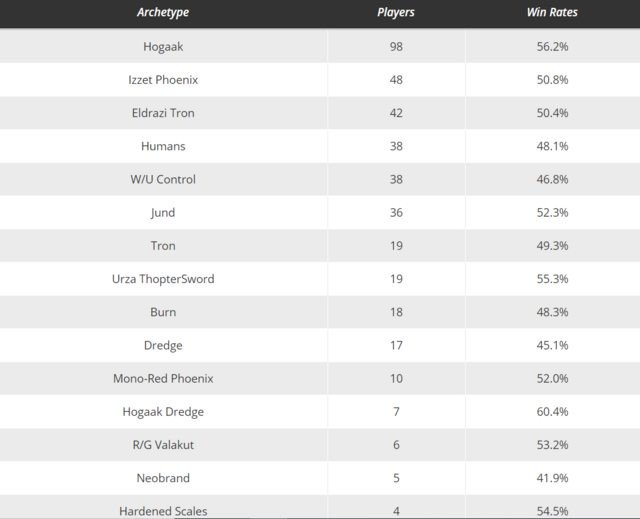
Despite only one copy reaching the Top 8, Hogaak made up the most decks that scored 8-2 or higher in the tournament, with 11 copies; the other 14 were spread across different archetypes, while most of the lists that succeeded in the event were made up of one of the few good strategies against it: ignore and try to be faster than the opponent to win the game, such as Tron, Mono Red Phoenix, Eldrazi Tron and Hardened Scales.
Its predominance continued in the following weeks, with five copies in the Top 8 of the Grand Prix Minneapolis, where the archetype made up 19.3% of the Metagame and the final of the event was starred by two players piloting Hogaak decks.
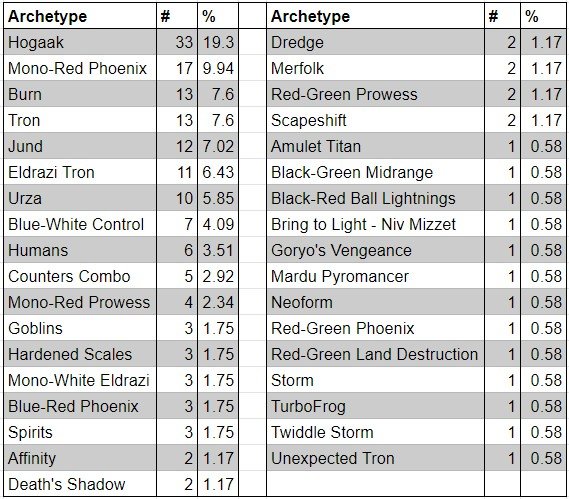
At Grand Prix Birmingham, Hogaak had an excellent conversion: from just 10% of the Metagame on Day 1, it went to 21.9% of decks on Day 2, and placed three copies in the Top 8, where Simon Nielsen lost the finals piloting Hogaak against Rory Kear-Smith, with Mardu Shadow.
At Grand Prix Vegas, with 1830 players, the archetype dominated the Top 8 with five copies, where Simon Nielsen won the event and gave Hogaak the last title before its ban.
July 26: Hogaak is banned
On July 26, 2019, Hogaak, Arisen Necropolis's reign of terror came to an end with the official announcement of its ban in Modern, as well as the departure of another powerful graveyard strategy enabler in the format: Faithless Looting.

With these changes, Modern underwent another significant transformation in the coming weeks while continuing to experience other troublesome interactions which led to the banning of other cards in the following months: Arcum's Astrolabe, Oko, Thief of Crowns, Mycosynth Lattice and Field of the Dead.
Who is the new Hogaak?
Whenever an explosive, very consistent strategy, or one that shares similarities with the Hogaak deck appears, social media is flooded with comments calling it the “new Hogaak”. Two examples of this case in 2023 were with the emergence of Boros Convoke and Abzan Amalia at Pioneer at the time of its conception and first results in competitive events.
Since then, the “new Hogaak” has seemed like a bad hyperbole that resurfaces whenever a new deck with expressive results appears, neglecting its gameplay standards, core points and legacy that made it so famous in the popular imagination.
For an archetype to become the new Hogaak, it must present numbers as impressive as its predecessor to the point of making the Metagame adapt around it and, even so, manage to remain at the top of the format - that is, to receive this title, foremost, its strategy needs to be very broken.
If we want to name the historical successor to Hogaak, perhaps we need to look a bit closer at Pauper, more specifically at the state of Affinity in the weeks following the release of Modern Horizons II.
In 2021, Pauper went through the biggest crisis in its history, where the Metagame was defined by three strategies: Storm, Affinity and Faeries, as MH2 cards made the first two archetypes too powerful compared to the rest of the format, with Faeries being the only one capable of competing against them due to their decent matchup against Storm.
During this period, Affinity was very similar to Hogaak: Its game plan allowed a “go wide” stance with Myr Enforcer and Sojourner's Companion, Atog allowed a “go big” and it still doubled as a potential combo-kill and Disciple of the Vault created enough support alongside Makeshift Munitions to bypass the combat phase to win, added to its now very consistent mana base, Affinity needed three bans on key cards to become a slightly fairer strategy.
Today, it is still one of the best decks in the format and forces players to maintain a high level of interaction with it between the maindeck and the sideboard to compete, making cards like Dust to Dust staples and often being in the threshold between great and broken.
Conclusion
Hogaak, Arisen Necropolis left a historic mark on Modern and Magic: The Gathering as the first design mistake coming from a product intended to affect eternal formats. This trend continued with Modern Horizons II, whose extension of its elemental cycle led to the banning of Fury years later in 2023.
Was it the most broken deck of all time? No, this title probably belongs to something released during the Urza's Saga era, requiring extensive research to define which was, in fact, the most broken competitive deck in Magic.
It also wasn't the most broken in Modern: this most likely belongs to the Eldrazi variants that emerged after Oath of the Gatewatch, but that's a story for when social media calls any strategy that does well for a few weeks a “Winter”.
Thanks for reading!

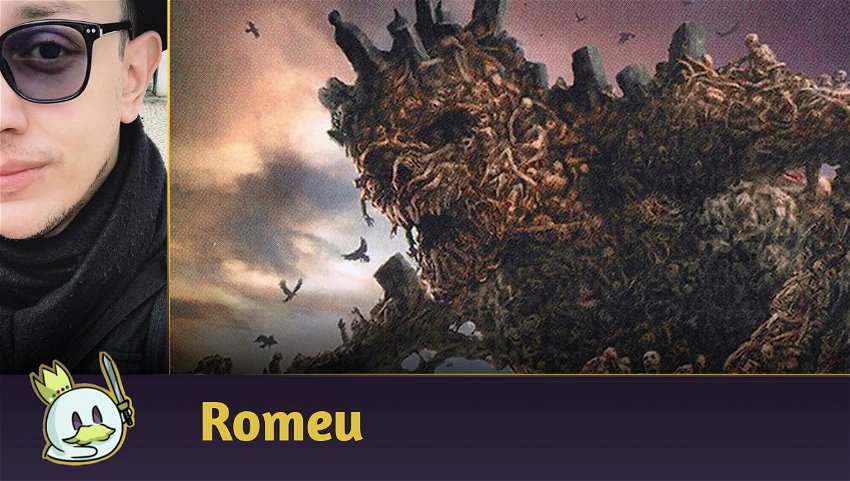







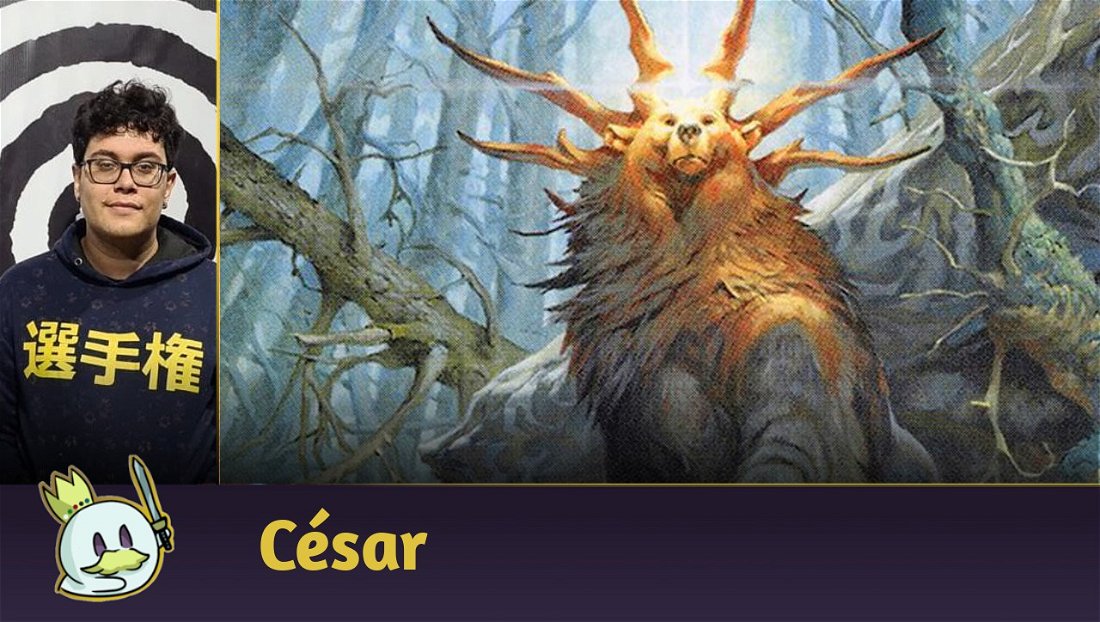
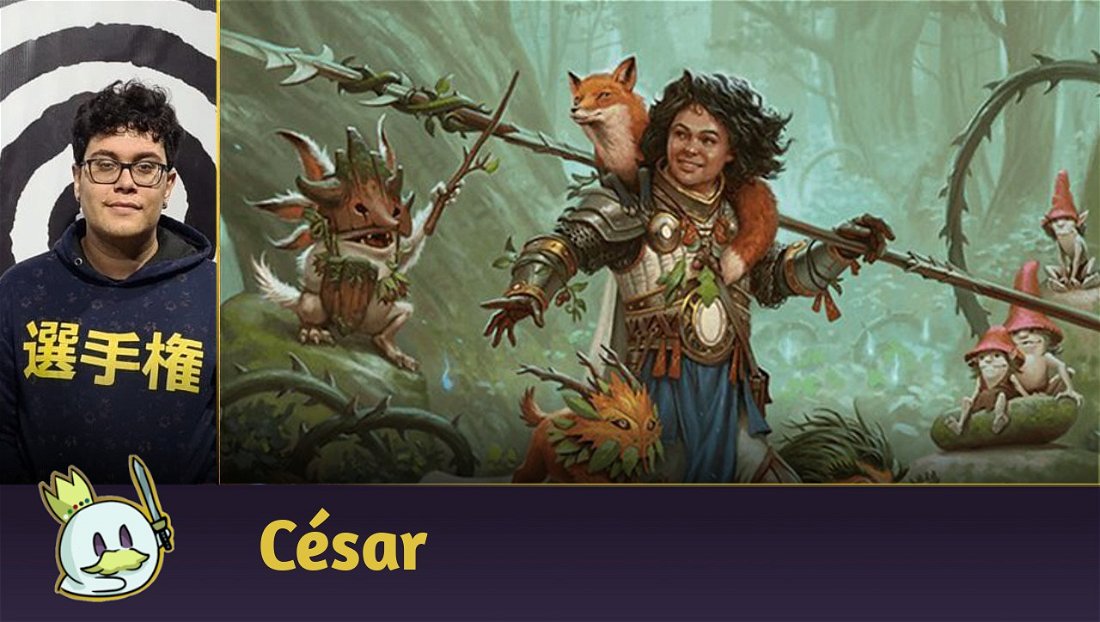



— Kommentare 0
, Reaktionen 1
Sei der erste der kommentiert